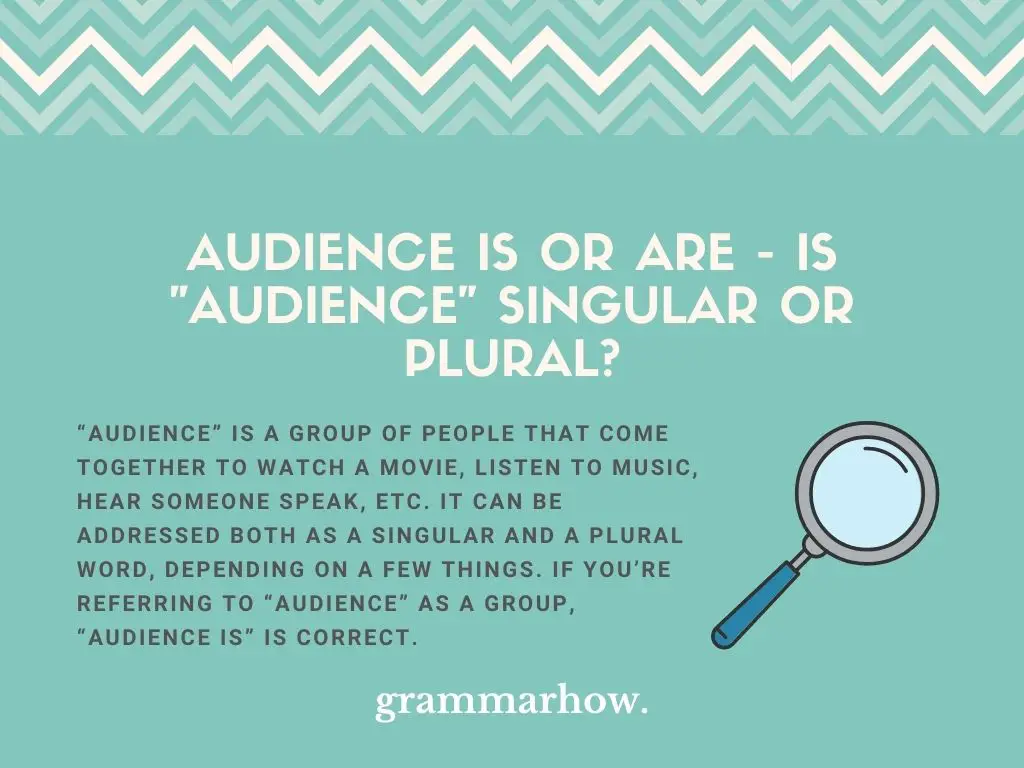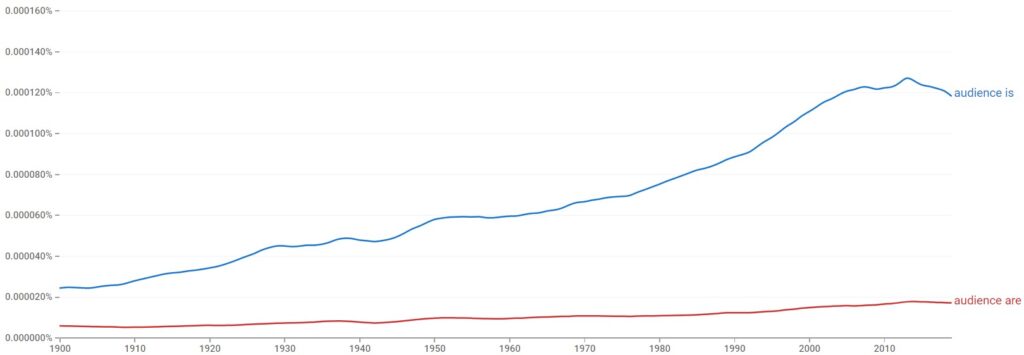When speaking about an audience, do you address it in the singular form or the plural form?
Because this word sounds singular but reflects a group of people, it isn’t uncommon that people would get confused choosing the verb to accompany it.
Audience Is or Are – Is “Audience” Singular or Plural?
“Audience” is a group of people that come together to watch a movie, listen to music, hear someone speak, etc. It can be addressed both as a singular and a plural word, depending on a few things. If you’re referring to “Audience” as a group, “Audience Is” is correct.

Take a look at the examples below:
- The audience is incredibly excited.
- The audience are incredibly excited. (incorrect)
- Many people in the audience are already leaving.
- Many people in the audience is already leaving. (incorrect)
In the examples, you find one situation where “Audience Is” is correct, and another where “Audience Are” is the appropriate form.
In the first set of examples, we have a sentence that addressed “Audience” as a collective, as a single unit. The whole “Audience Is” excited, and that’s why this is the appropriate form here.
In the second set of sentences, some people in the audience stand out, because “many people in the audience” are leaving. In that scenario, the verb should agree with “many people”, and consequently, the correct form is “Audience Are”.
Is “Audience” A Collective Noun?
Collective nouns indicate a group of things, being treated as one single collective. In that sense, “Audience” is a collective noun. Keep in mind that collective nouns are most commonly treated in the singular form, and not the plural. In that case, you say “Audience Is”.
Audience Is
“Audience Is” should be used every time the word “Audience” is being applied in the sense of a collective noun. If your sentence or speech is treating the “Audience” as a big unity, this is the form you should choose.
Take a look at some examples:
- The audience is booing the band.
- The audience is mostly made up of men.
- The audience is clearly upset about the talk show host’s comments.
- The audience is screaming in excitement.
- At the office, the audience is tough, so you better be prepared.
Audience Are
“Audience Are” isn’t as common as “Audience Is”, but can be used in some instances, when you’re setting a group of the audience apart, for example. Also, there are situations in which the plural “Audiences” is what you want to use, and in that case “Audiences Are” are also correct.
Lat’s go over some examples:
- Most people in the audience are cheering, following the team’s goal.
- The women in the audience are laughing loudly at the joke.
- Audiences are impacted by the movie, all over the world.
- Formal audiences are to be approached accordingly.
- The audience are clapping. (incorrect)
- The audience is clapping.
The examples show three different scenarios.
Sentences 1 and 2 show a group amongst the audience that stands out. We’re talking about “most people in the audience” and “women in the audience”. In those cases, because we aren’t addressing the audience as a whole, the correct form is “Audience Are”.
Sentences 3 and 4 show the idea of many audiences, in the plural form. In those cases, as it’d be the case with any word in the plural form, the correct is also “Audiences Are”.
Sentences 5 and 6 show an example of the word “Audience” being addressed as one big collective. In that scenario, “Audience Are” is incorrect, and “Audience Is” should be used.
Which Is Used the Most?
Which one of those forms is used more often, “Audience Is” or “Audience Are”? Take a look at the graph from Google Ngram Viewer below.

As expected, “Audience Is” is used much more often than “Audience Are”. If we remember that “Audience Are” is sort of an expectation to the rule, it makes sense that this form wouldn’t be the one to pop up most frequently.
The Target Audience Is or Are?
“The Target Audience” is a set phrase, and indicates a big collective of people that marketing efforts wish to reach and captivate. Consequently, just like an audience in general, which is considered a single unit, it should be addressed in the singular form as “The Target Audience Is”.
Take a look at the example:
- The target audience is middle-aged men.
- The target audience are middle-aged men. (incorrect)
